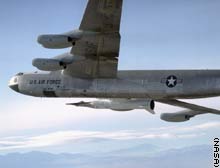Wow....sometimes I think of myself as very fortunate to actually witness first hand aviation history. The other day I happend to actually See the X43A underneith the wings of the historic B-52 008. Good article though
http://www.cnn.com/2004/TECH/space/03/24/plane.nasa/index.html
Fifty-seven years after combat pilot Chuck Yeager broke the sound barrier, NASA will make a second attempt Saturday at flying an aircraft at 5,000 mph -- about seven times Mach 1, the speed of sound.
The space agency's dogged pursuit of extreme speed, officials hope, will ultimately make space flight easier to accomplish.
NASA will roll out the X-43A, capable of reaching speeds more than Mach 7, in a test flight over the Pacific Ocean. The Hyper-X, as it is called, could also give rise to commercial planes that zip passengers between London and New York in less than two hours.
"It's relatively simple in its concept," said Griff Corpening, chief engineer for the X-43A program. "It's incredibly challenging in its execution.... [That is] where 40 plus years of research comes in."
The $250-million Hyper-X program has already attracted the interest of the Air Force and private aerospace companies such as Boeing. But dreams of civilian spin-offs are at least 20 years away, said NASA officials, who are betting the program will first lead to a more durable, cheaper workhorse for the space fleet.
And the future of the program could be hindered by budget cuts as NASA attempts to establish a moon base and launch a manned Mars expedition under an initative by the Bush Administration.
The diminutive, 12-foot-long X-43A test craft will ride atop a Pegasus booster rocket launched from a converted B-52 bomber off southern California. The flight will test aspects of a design to allow planes to overcome the pull of Earth's gravity by reaching 25,000 mph, also known as escape velocity.
During the test, the 49-foot-long booster rocket will propel the X-43A to about 3,700 mph before the experimental plane detaches from the rocket and flies under its own power using a hydrogen-powered "scramjet" engine, the first such test of the technology.
The actual powered-flight is expected to last about 10 seconds and reach Mach 7 before gliding for six minutes and plunging into the Pacific Ocean.
The test will gather crucial information for engineers and scientists trying to make the X-43A NASA's platform for reusable spacecraft and hypersonic planes, or those traveling above Mach 5.
It will be the first time aircraft have detached in mid-flight for hypersonic flight.
"We've never separated two vehicles going Mach 5," said Leslie Williams, spokeswoman for NASA's Dryden Flight Research Center which is overseeing the test. "That's just never happened. It's a very risky thing."
First attempt ends in explosion
The last attempt in 2001 was aborted after stabilizing fins flew off the plane's booster rocket. Controllers ordered the craft destroyed. Researchers blamed a flight control system failure and unanticipated stresses on the rocket.
Since then, a redesign and test changes have reduced the risks, researchers said, but some aspects of the X-43A's propulsion and aerodynamic design remain unproven. Simulating such high speeds on the ground remains difficult.
In many respects, this will be the first trial for crucial technology employing air-breathing "scramjet" engines instead of bulky and expensive chemical rockets to leave the atmosphere. The new engines promise to dramatically lower the risks and expense of flight by freeing spacecrafts from massive and potentially explosive fuel tanks.
"It's hard to say what the future is going to lead to," said Williams. "The [scramjet engines] have been in the wind tunnel for 20 years, but a lot of people will be interested to see if it works in free flight."
Scramjets operate at "hypersonic" speeds by burning hydrogen mixed with compressed air scooped from the atmosphere. There are no moving parts. Instead, sophisticated geometry in the engine allows hydrogen to combust with air moving through the engine at supersonic velocities.
At that speed, a molecule of air stays in the engine for just a millisecond. That creates an enormous amount of thrust -- the exact amount of which is classified -- for an engine which can be reused throughout the life of an aircraft.
In theory, such engines will push crafts beyond Mach 10 and, with the help of chemical rockets, escape Earth's gravitational pull and achieve orbit. That kind of craft would probably employ multiple propulsion systems including a turbo-jet to reach supersonic speeds, scramjets to take the vessel to the edge of the atmosphere and then chemical rockets to enter the void of space.
Searching for a shuttle replacement
But a string of canceled programs and engineering failures have hindered progress. A thrifty and reliable replacement for the agency's problematic space shuttles is still years, if not a decade, away.
Congressional belt-tightening and the cost of shuttle launches (now more than $10,000 per pound; that's about $500 million per flight), have intensified efforts to find a replacement.
It was hoped one could be developed during the last decade, but plans to retire the aging shuttle fleet, now on a deadline of 2010 by President Bush, have floundered.
Engineering obstacles, budget troubles and two space shuttle disasters with Challenger and Columbia swept away a number of promising ideas.
NASA officials maintain that the Hyper-X program will continue regardless of budget cuts.
Keith Henry, spokesman for NASA's Langley Research Center in Virginia, said any reduction in funding would only delay the program, not derail it.
"NASA's primary interest is cheaper, more flexible and safer access to space," he said. "It just means the application is a little further."